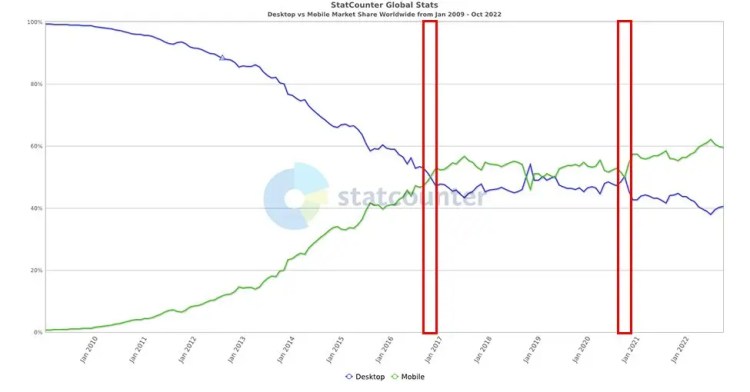Is there a relationship between mobile-friendliness and SEO ranking? Absolutely. However, let’s dig into this question and explore the why behind mobile-friendliness and how it impacts SEO ranking.
First and foremost, surfing the web on a mobile device is the norm today. If you disagree, you’re wrong. However, we used to explore the internet on desktops and laptops. This fell out of practice in late 2016 when people started using mobile devices more often (see chart below). The transition from desktop to mobile went back and forth for a few years. However, mobile browsing took off in late 2020 and never looked back.

Back in the day, Google didn’t care if a site performed well on mobile devices. Mobile-friendliness was considered a nice-to-have feature but was by no means required. However, as smartphones and tablets grew in popularity, Google reconsidered the value of mobile-friendliness as a ranking factor. This shift led to an event most known as “mobilegeddon,” which solidified the fact that mobile search was no longer an afterthought. In this post, we’ll explore the claims and confirm that mobile-friendliness impacts search rankings.
Is Mobile-Friendliness a Ranking Factor?
Countless SEO professionals state that websites that fit mobile devices benefit from a ranking boost over sites that only fit on desktops. This claim stems from many searches completed on mobile devices and the understanding that Google aims to serve content with the best user experience.
Since most users search via mobile, the best user experience is provided when content is optimized for both mobile and desktop. This is often referred to as a responsive website. Before mobile search dominated, it was common for users to land on pages not optimized for their mobile devices. Today, it’s uncommon to conduct a search on a mobile device and land on a page that isn’t optimized for a smartphone.
This trend may lead you to wonder – is it because mobile friendliness is a ranking factor? Or are there more mobile-friendly sites on the web today than in past years?
It’s likely a mix of both – here’s what the evidence says.

Mobile-Friendliness is a Ranking Factor
Naturally, mobile users grew frustrated when they encountered pages they couldn’t easily navigate. This meant that Google had a search quality issue.
Webmasters could take years to make their sites mesh with all devices without an incentive. Heck, they might not bother to do it at all.
Google couldn’t force sites to adopt a responsive design, and it wouldn’t be fair to threaten websites with penalties for having an outdated design.
Instead, Google found an alternative route and rewarded websites with a responsive design.
When Google launched its “mobile-friendly update,” it stated:
“As we noted earlier this year, today’s the day we begin globally rolling out our mobile-friendly update. We’re boosting the ranking of mobile-friendly pages on mobile search results.
Now searchers can more easily find high-quality and relevant results where text is readable without tapping or zooming, tap targets are spaced appropriately, and the page avoids unplayable content or horizontal scrolling.”
— “Rolling Out the Mobile-Friendly Update” (April 21, 2015)
Then, in 2016, Google announced that it would strengthen the mobile-friendly ranking signal:
“Today we’re announcing that beginning in May, we’ll start rolling out an update to mobile search results that increases the effect of the ranking signal to help our users find even more pages that are relevant and mobile-friendly.”
— “Continuing to Make the Web More Mobile Friendly” (March 16, 2016)
In short, Google designed the mobile-friendly update to impact mobile search results.
There was no boost for responsive sites when a user searched on a desktop.
To further highlight the value of responsive design, Google adopted a new indexing method that ditched the desktop crawler in 2020.
Mobile-first indexing is now the gold standard. This means that the algorithms use the mobile version of a page instead of the desktop version.
While mobile-friendliness as a ranking factor has increased over time, Google reminds us that user intent is a more robust signal.
A page not optimized for mobile can still rank in mobile search results when it’s the best match for what a user seeks. However, Google offers the following:
“While it’s not required to have a mobile version of your pages to have your content included in Google’s Search results, it is very strongly recommended.”
— Mobile-First Indexing Best Practices
The ranking advantages provided to mobile-optimized sites led to the adoption of responsive web design on a larger scale.

Mobile-Friendliness is a Confirmed Ranking Factor
Mobile-friendliness is, without question, a Google ranking factor.
If a webpage provides less information on the mobile version than on the desktop version, then Google won’t have as much context to consider when ranking it.
There’s potential to hinder your ranking if your site provides a lesser experience on mobile than you do on desktop.
Responsive mobile design is a critical component of a positive user experience. That’s not an opinion. It’s clearly outlined in Google’s page experience algorithm update, which was also introduced in 2020.
As the name suggests, the page experience update offers a boost when visitors can easily interact with and navigate your website. It includes the following factors:
- Mobile usability
- HTTPS
- Core Web Vitals
- No intrusive interstitials
At the end of the day, it’s safe to conclude that non-responsive websites are at a disadvantage with Google.
Businesses with outdated website designs should consider upgrading their online presence to remain competitive on Google’s SERPs.





